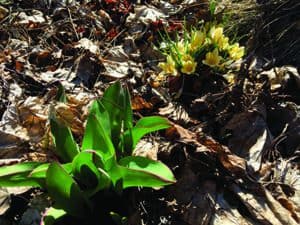By Bonnie Kirn Donahue, UVM Extension master gardener
It’s spring and that means it’s time to get back into your flower and vegetable gardens.
Once the soil has dried out in your flower gardens, remove any sticks, dried leaf debris and old mulch, being careful not to step on any emerging plants.
Use this time to think about how you can build your garden’s soil health by adding organic matter. Dried leaf debris can be chopped fine with a lawnmower, collected and worked back into the soil. Adding a layer of compost or mulch to your soil are other ways to do this.
If you left your perennial flower heads and stems intact over the winter for bird and insect habitat, it’s time to trim these back. Try to cut these old stems as close as you can to the ground (within an inch or so). The new growth will begin to grow from the base, so be mindful of what you are trimming.
When the soil is dry enough, you can add your first application of mulch for the season. There are many types of mulch. Consult with the experts at your local garden center to determine which mulch is best for you.
Plan to spread 2-3 inches of mulch over the garden. After spreading, pull the mulch away from the base of each plant as too much will encourage rot.
In gardens with spring-flowering bulbs, you’ll want to be extra careful. You may even decide to leave the cleanup and mulching until after the bulbs have finished blooming to protect them.
For your vegetable beds, clear out any plant matter from last season. This can be added to a compost pile as long as it is not diseased or insect-infested.

When cleaning out flowerbeds, gently remove any dried leaf debris and old mulch, taking care not to disturb spring-flowering and other emerging plants.
Once you have cleaned out your beds, add a layer of compost or finely chopped plant material, such as dried leaves, grass or hay, to return organic matter back to the soil.
Some years spring can arrive quickly, and other times it seems to take forever. Either way, take this time to think about what you’d like to get out of your garden this year.
More flowers in your vegetable beds? Healthier tomatoes? Experimenting with new herbs? Want to try growing zucchini in a container?
Start by taking a few minutes to reflect on the lessons you learned from last season, and your desires for this season. From here, pick your top two or three priorities, and outline the steps needed to accomplish these. Perhaps you need to do more research, purchase materials, hire a garden designer or just get digging. Spring is the perfect time to do all these.
Taking advantage of the spring slow period by doing light garden cleanup and setting a realistic plan in place will help you get the most out of your summer vegetable and flower gardens.




